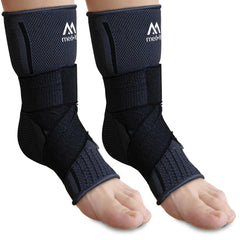Free UK Mainland Shipping on Orders Over £25 (ex VAT)
Ankle Supports
(0)
No products found in this collection.
When Should I Wear an Ankle Support?
Ankle supports are commonly used by individuals who need additional stability, particularly those with weak ankles or those recovering from an injury. While some wear ankle supports for everyday activities, many use them when participating in physical activities, especially sports, or to prevent further injury during recovery. Ultimately, wearing an ankle support depends on your individual needs, the severity of your injury, and the type of activities you engage in.
Here are some of the most frequently asked questions when it comes to ankle support:
Can I Wear an Ankle Brace in Bed?
Yes, you can wear an ankle brace in bed, though it's primarily a matter of personal preference. Typically, when your leg is elevated and at rest—especially during recovery—it is common to remove the ankle support to allow your ankle to relax. This can help reduce stiffness and improve circulation. However, if you're recovering from severe injuries like ligament tears or fractures, wearing the brace overnight may be beneficial to stabilise the joint. It’s important to consult with a healthcare professional if you’re unsure whether you should keep it on while sleeping.
Wearing an Ankle Support at Home
For those recovering from more severe injuries, such as sprains, strains, or fractures, wearing an ankle support at home is often recommended. The extra support can help stabilise the ankle and prevent further injury while moving around. For mild to moderate injuries, wearing the support indoors may not be necessary unless you're experiencing balance issues or difficulty walking.
Going Out and Daily Activities
Ankle supports are particularly useful when venturing outside for daily activities. They provide essential stability, especially on uneven terrain or when navigating through crowded spaces. Wearing an ankle brace during outdoor activities reduces the risk of further injury, which is especially helpful if you have a history of ankle problems.
Ankle Supports for Sports and Recreational Activities
Engaging in sports or recreational activities puts a higher strain on your joints, increasing the risk of aggravating past injuries or developing new ones. If you're nearing the end of your recovery and plan to return to physical activities, wearing an ankle support is highly recommended. It provides added stability, minimises the risk of future injuries, and allows you to perform with greater confidence. Adjustable compression straps ensure a snug fit and can be customised for optimal support.
Should I Wear an Ankle Brace All Day?
Wearing an ankle brace throughout the day is generally safe, but it’s advisable to consult a medical professional to avoid potential issues. Some experts may recommend wearing the brace only during physical activity to prevent dependency on external support, which could weaken the ankle muscles over time. Your healthcare provider will be able to offer tailored advice on the duration of wear and when it's best to remove the brace, possibly during rest periods or overnight.
Can Ankle Supports Help Reduce Swelling?
Swelling is a common side effect of injuries such as sprained ankles or fractures. Ankle supports that offer compression help control swelling by promoting better blood circulation. The gentle pressure applied to the ankle encourages fluid movement and lymph drainage, reducing inflammation. For instance, the Stride Flex ankle support incorporates 360-degree compression, which can aid in reducing swelling and alleviating pain. It’s crucial to monitor the tightness of the brace—if it feels too constricting or if swelling occurs above the support, it may be too tight and should be adjusted or removed.
How Ankle Supports Can Improve Healing
Ankle recovery depends heavily on movement, as it facilitates the flow of synovial fluid within the joint. This fluid is necessary to nourish the joint and keep it functioning properly. Ankle supports allow for controlled movement, which strengthens the muscles and ligaments around the ankle while preventing overextension and further injury. This carefully monitored movement is essential for the healing process, as it ensures the joint remains active and promotes the circulation of nutrients and oxygen to the injured area.
Do Ankle Supports Work?
Ankle braces are a highly effective preventative measure for reducing ankle injuries, especially during activities like sports and running. Studies suggest that wearing an ankle brace is more effective than taping, as it provides more consistent support and reduces the likelihood of recurring sprains. Well-designed braces, particularly those that cover both the ankle and the foot, can significantly enhance joint stability and prevent unwanted movement.
A brace works by limiting harmful motions like inversion (rolling the ankle inward) or plantar flexion (pointing the toes down), helping to stabilise the joint and reduce the risk of future injuries. For optimal performance, ensure the brace fits comfortably within your shoe, as this improves its overall effectiveness.
FAQ’s
Should I wear an ankle support for a sprained ankle? Ankle sprains often cause significant swelling, and ankle supports are helpful in managing this swelling. The compression from an ankle brace helps with fluid movement and reduces inflammation, which is essential during the recovery phase. Using an ankle brace can also provide stability to the joint, minimising the risk of further injury as you resume daily activities.
What is the best ankle support for arthritis? When choosing an ankle support for arthritis, look for one that offers a balance of compression and stability. Arthritis typically requires a support that reduces joint pain and provides relief from inflammation. The Stride Flex ankle brace, with its adjustable compression and four-way stretch, is ideal for those dealing with arthritis or tendonitis. The snug fit enhances circulation and reduces joint stiffness, making it easier to remain active without discomfort.
By incorporating ankle supports into your recovery or injury prevention routine, you can gain additional stability and improve the healing process. Always consult with a healthcare provider to determine the best approach for your specific condition and needs.

